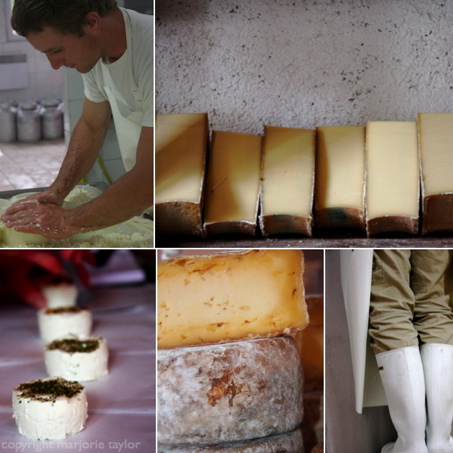
primary-image, l
(post, Marjorie Taylor)

primary-image, l
I just recently returned from Valloire, a tiny mountain village located in the French Alps. Specifically, it is located in the Savoie department in the Rhône-Alpes region in southeastern France. The region is known for its pedigreed beef, wonderful milk, cream and cheese and is blessed with several artisan producers who are passionate about preserving the culinary traditions of the area. The traditional food of the area is a "stick to your ribs" type of fare; think fondue, crusty breads, potatoes and artisan sausage served with wine from the region or a glass of cold beer. My days were spent visiting the little hamlets in the area and enjoying picnics near the river on the green slopes just outside the little village. The sky was bright blue and the ground was covered with an amazing assortment of wild flowers. All was quiet except for the distant sound of the bells on the sheep while they grazed just up the hill. To say it was picturesque is an understatement. There are plenty of well maintained little potagers dotting the countryside as well as little patches dedicated to the art of keeping bees. They have a weekly market in Valloire that surrounds the beautiful baroque style church in the center of the village that features artisan sausage makers, regional cheese from the area such as Beaufort (cow), Chevrotin (goat) and Reblochon, made from raw cow's milk and honey made from the wild alpine flowers. It was during this visit that I had the pleasure of meeting Monsieur Christophe Traviegnet, the cheese maker at La Ferme du Pré Clos. By definition, farmstead cheese is a type of artisan cheese that is made traditionally from milk from the producer's own herd of cows, sheep or goats. Artisan cheese is made by hand using the craftsmanship of skilled cheese makers and the taste of the cheese reflects the care of the cheese maker as well as the terrior of where it is produced. I arrived at the creamery mid-morning to a little crowd already gathered who were interested in learning more about the art of making cheese. We tasted fresh cow's milk from that morning's milking as we sampled an assortment of cheese made on the farm. On the day I visited, M. Traviegnet was making a Tomme cheese. Tomme is a type of cheese, and is a generic name given to a class of cheese produced mainly in the French Alps. They are normally produced from the skim milk left over after the cream has been removed to produce butter and richer cheeses. I spent the morning with him as he worked and I can honestly say this was one of the best mornings of my trip. It is exciting to meet people who are so passionate about what they do and who are dedicated to the preservation of culinary traditions. Things around here have a natural order to them. People do what they love and they seem to be connected to the land. It's very local, not just a saying or a movement, it's just the way it is. After finishing his morning making cheese, M. Traviegnet drained off the remaining whey and returned it to the milk buckets and mentioned that he would be giving it to his pigs. It's a great example of sustainabilty and coming full-circle on the farm. Thanks to a new generation of farmstead cheese makers, traditional cheese making is becoming more and more popular in America and many come to France to learn their trade. Be sure to seek out the artisan cheese makers in your local market and do your part to help preserve this culinary tradition. Marinated fresh goat cheese Marinating goat cheese will give it more flavor. It is the perfect accompaniment for rustic bread or a green salad from your garden. Small fresh goat cheeses, approximately 2 ounces each Extra-virgin olive oil, preferably organic Pink peppercorns Fresh thyme Place the cheeses in a jar and add the oil to cover. Add the peppercorns and thyme to taste. Cover the jar tightly and refrigerate for up to 2 weeks. It is important to keep the cheese completely submerged in the olive oil. You may use the olive oil in the dressing for the salad.